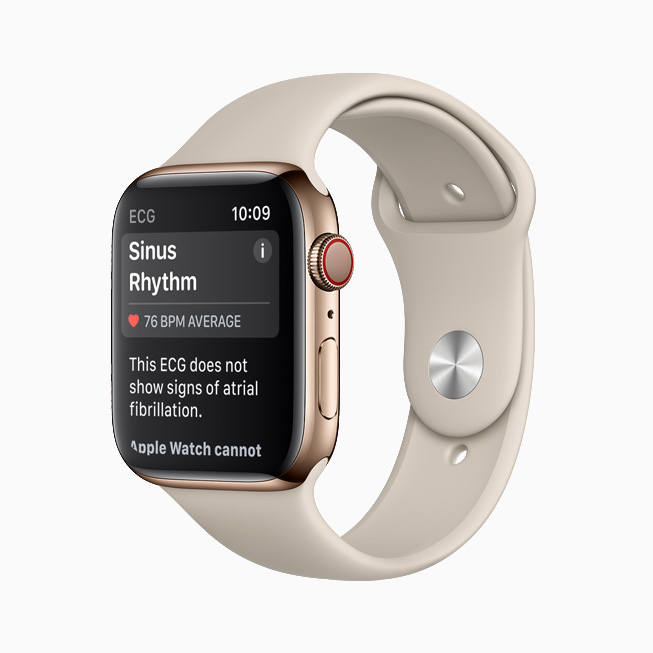UPDATE
19 March 2020
ECG app and irregular heart rhythm notification available next week on Apple Watch
The ECG app on Apple Watch Series 4 and later will be available in New Zealand next week with iOS 13.4 and watchOS 6.2. The feature marks the first direct-to-consumer product that enables customers to take an electrocardiogram right from their wrist, capturing heart rhythm in a moment when they experience symptoms like a rapid or skipped heart beat and helping to provide critical data to physicians. The irregular rhythm notification feature on Apple Watch Series 1 or later will also occasionally check heart rhythms in the background and send a notification if an irregular heart rhythm that appears to be atrial fibrillation (AFib) is identified.
The ECG app1 and irregular heart rhythm notification feature2 will help users identify signs of AFib, the most common form of irregular rhythm. When left untreated, AFib is one of the leading conditions that can result in stroke, the second most common cause of death around the world.
“Apple Watch has helped so many people around the world and we are humbled that it has become such an important part of our customers’ lives,” said Jeff Williams, Apple’s chief operating officer. “With the release of these heart features, Apple Watch takes the next step in empowering people with more information about their health.”
“We are confident in the ability of these features to help users have more informed conversations with their physicians,” said Sumbul Desai, MD, Apple’s vice president of Health. “With the ECG app and irregular rhythm notification feature, customers will be able to better understand aspects of their heart health in a more meaningful way.”
ECG App
New electrodes built into the back crystal and Digital Crown on Apple Watch Series 4 and later work together with the ECG app to enable customers to take an ECG similar to a single-lead reading. To take an ECG recording at any time or following an irregular rhythm notification, users launch the new ECG app on Apple Watch Series 4 and later and hold their finger on the Digital Crown. As the user touches the Digital Crown, the circuit is completed and electrical signals across their heart are measured. After 30 seconds, the heart rhythm is classified as either AFib, sinus rhythm, low or high heart rate or inconclusive. All recordings, their associated classifications and any noted symptoms are stored securely in the Health app on iPhone. Users can share a PDF of the results with physicians.
Irregular Rhythm Notification
Using the optical heart sensor in Apple Watch Series 1 or later, the irregular rhythm notification feature will occasionally check the user’s heart rhythm in the background for signs of an irregular heart rhythm that appears to be AFib and alerts the user with a notification if an irregular rhythm is detected on five rhythm checks over a minimum of 65 minutes.
The ECG app’s ability to accurately classify an ECG recording into AFib and sinus rhythm was validated in a clinical trial of around 600 participants. Rhythm classification from a gold standard 12-lead ECG by a cardiologist was compared to the rhythm classification of a simultaneously collected ECG from the ECG app. The study found the ECG app on Apple Watch demonstrated 98.3 percent sensitivity in classifying AFib and 99.6 percent specificity in classifying sinus rhythm in classifiable recordings. In the study, 87.8 percent of recordings could be classified by the ECG app.
The irregular rhythm notification feature was studied in the Apple Heart Study. With over 400,000 participants, the Apple Heart Study was the largest screening study on atrial fibrillation ever conducted, also making it one of the largest cardiovascular trials to date. A subset of the data from the Apple Heart Study was submitted to the FDA to support clearance of the irregular rhythm notification feature. In that sub-study, of the participants that received an irregular rhythm notification on their Apple Watch while simultaneously wearing an ECG patch, 80 percent showed AFib on the ECG patch and 98 percent showed AFib or other clinically relevant arrhythmias.
To enable these new heart features, customers will be taken through an onscreen setup flow that includes details about who can use these features, what the features can and cannot do, what results users may get, how to interpret those results and clear instructions for what to do if users are feeling symptoms that require immediate medical attention.
Images of Apple Watch Series 5
- 1 This feature is available on Apple Watch Series 4 or later in Austria, Belgium, Canada, Chile, Denmark, Finland, France, Germany, Greece, Guam, Hong Kong, Hungary, India, Ireland, Italy, Luxembourg, Netherlands, New Zealand, Norway, Portugal, Puerto Rico, Romania, Singapore, Spain, Sweden, Switzerland, Turkey, the UK, US and US Virgin Islands, and requires the latest version of iOS and watchOS, on Apple Watch Series 4 or later. The ECG app does not detect a heart attack, blood clots, a stroke or other heart-related conditions including high blood pressure, congestive heart failure, high cholesterol or other forms of arrhythmia.
2 This feature is available with the latest version of iOS and watchOS in Austria, Belgium, Canada, Chile, Denmark, Finland, France, Germany, Greece, Guam, Hong Kong, Hungary, India, Ireland, Italy, Luxembourg, Netherlands, New Zealand, Norway, Portugal, Puerto Rico, Romania, Singapore, Spain, Sweden, Switzerland, Turkey, the UK, US and US Virgin Islands. The irregular rhythm notification feature does not detect a heart attack, blood clots, a stroke or other heart-related conditions including high blood pressure, congestive heart failure, high cholesterol or other forms of arrhythmia.





